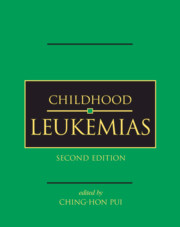Book contents
- Frontmatter
- Contents
- List of contributors
- Preface
- Part I History and general issues
- Part II Cell biology and pathobiology
- Part III Evaluation and treatment
- 14 Pharmacokinetic, pharmacodynamic, and pharmacogenetic considerations
- 15 Assays and molecular determinants of cellular drug resistance
- 16 Acute lymphoblastic leukemia
- 17 Relapsed acute lymphoblastic leukemia
- 18 B-cell acute lymphoblastic leukemia and Burkitt lymphoma
- 19 Acute myeloid leukemia
- 20 Relapsed acute myeloid leukemia
- 21 Myelodysplastic syndrome
- 22 Chronic myeloproliferative disorders
- 23 Hematopoietic stem cell transplantation
- 24 Acute leukemia in countries with limited resources
- 25 Antibody-targeted therapy
- 26 Adoptive cellular immunotherapy
- 27 Gene transfer: methods and applications
- 28 Minimal residual disease
- Part IV Complications and supportive care
- Index
- Plate Section between pages 400 and 401
- References
25 - Antibody-targeted therapy
from Part III - Evaluation and treatment
Published online by Cambridge University Press: 01 July 2010
- Frontmatter
- Contents
- List of contributors
- Preface
- Part I History and general issues
- Part II Cell biology and pathobiology
- Part III Evaluation and treatment
- 14 Pharmacokinetic, pharmacodynamic, and pharmacogenetic considerations
- 15 Assays and molecular determinants of cellular drug resistance
- 16 Acute lymphoblastic leukemia
- 17 Relapsed acute lymphoblastic leukemia
- 18 B-cell acute lymphoblastic leukemia and Burkitt lymphoma
- 19 Acute myeloid leukemia
- 20 Relapsed acute myeloid leukemia
- 21 Myelodysplastic syndrome
- 22 Chronic myeloproliferative disorders
- 23 Hematopoietic stem cell transplantation
- 24 Acute leukemia in countries with limited resources
- 25 Antibody-targeted therapy
- 26 Adoptive cellular immunotherapy
- 27 Gene transfer: methods and applications
- 28 Minimal residual disease
- Part IV Complications and supportive care
- Index
- Plate Section between pages 400 and 401
- References
Summary
Introduction
No one stands to benefit more from targeted therapy strategies than children with cancer. Although conventional chemotherapy induces pancytopenia and mucositis that augment the risk of life-threatening infections in patients of all ages, younger patients are particularly vulnerable to late toxicities due to a lack of chemotherapy specificity for malignant cells. Such effects include, but are not limited to, cardiotoxicity, pulmonary insufficiency, sterility, hormone deficiency, and the development of secondary malignancies. Although the dose intensity of treatment regimens for acute lymphoblastic leukemia (ALL) and Hodgkin disease has declined substantially in recent years, children with acute myeloid leukemia (AML) currently receive the highest dose intensity of chemotherapy that has ever been delivered. While a higher proportion of children with AML treated in this manner experienced prolonged disease-free survival, compared with those who received a less aggressive induction regimen, their overall survival was somewhat reduced by a higher induction death rate in this randomized arm. Strategies that target therapies directly to malignant cells could conceivably spare normal tissues from injury, resulting in a substantial improvement in the long-term quality of life of children who achieve remissions. The use of monoclonal antibodies as a means of delivering either chemotherapy or radiation directly to leukemic blast cells or, in the setting of hematopoietic stem cell transplantation (HSCT), as a means of targeting increased doses of radiation to sites of normal and malignant hematopoiesis (Table 25.1) will be reviewed in this chapter.
- Type
- Chapter
- Information
- Childhood Leukemias , pp. 639 - 647Publisher: Cambridge University PressPrint publication year: 2006



